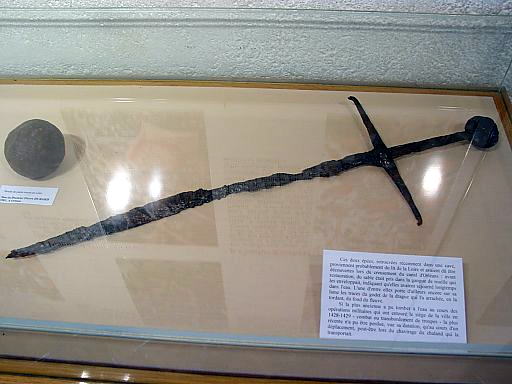Posts: 354 Location: Dijon
Mon 18 Dec, 2006 4:34 pm
Hi all
There are at least 3 swords attributed to Joan of Arc in France.
But the one you're reffering to is actually kept at the Musée des Beaux Arts in Dijon - it should be no surpise that its website doesn't mention it, as most French museum curators (and their co-workers) are not much into arms and armour anyway (though we'll try to change that, the new curator Sophie Jugie and I). At the moment (until it came back from normandy), the sword is in Rouen, for a temporary exhibition on Joan of Arc. I'm just sitting here waiting for it to be back.
A better description (in French) of this sword exists in
La Revue de Bourgogne, year 1914 (in the same volume you'll find an interesting article on the history of Salles d'Armes in Dijon between 1500 and the French Revolution, but this is completely OT :) ), as well as in several other publications - it stirred quite the debate, the echoes of which sounding from England to Belgium to Italy.
To sum things up, and until I manage to examine the sword myself, all we can say is that the 84 cm blade (5 cm wide and 5.6 mm thick at forte) appears to be quite similar to a genuine type XV of the XVth century (some sources mention a Toledo origin for the blade BTW), while the 8.5 cm handle and 5.7x4.8x2.5 mm pommel are obviously later replacements ; the S-shaped cross-guard shows evidence of cutting the former (presumably straight) quillons, and replacing them with curved ones, welded on. There is a complex decoration on the blade, that I will not detail here due to lack of time mostly, but enough is to know that it is engraved, was once gilded, and that armorial features, as well as the name of King
Charles VII and the date of 1419 appear repeatedly. However, this date (1419) appears irrelevant to the reign of the French monarch (started in 1422) or to the life of Joan of Arc - the only major historical event taking place then being the assassination of Duke John of Burgundy in Montereau.
Furthermore, the cross featured on the decoration is shown with a perspective not compliant to the XVth century ways of treating volumes and spaces. There are also other features - mainly related to spelling and shapes of letters - that indicate a later date for the decoration.
Still, it could be that this sword belonged to Joan. It is also likely, in any case, that this sword was kept in the Dukes of Burgundy's armouries since then. But other theories are equally valid.
I'd like to add that, before M. Metman's article, this sword was not attributed to Joan, but simply quoted as an "Epée du temps de Chalres VII" in the archives and registers.
But all this is after Metman's article in
La Revue de Bourgogne. Once I get to get my hands on this sword, and if myArmoury's administrators agree to that - AND, more important, if my other duties allow me to do so, I'd happily write a review of this sword for this website.
Hope this helps
Fab
